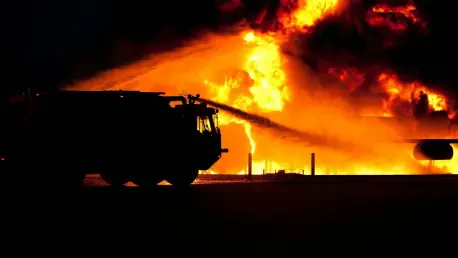In the small town of Roseland, Louisiana, a catastrophic explosion at Smitty’s Supply has left the community grappling with ash-covered streets and an unrelenting fire that has burned for days, posing severe environmental and safety challenges. This devastating incident, which erupted on a Friday afternoon, has transformed a quiet area into a hub of emergency response activity. Initially managed by the company itself in collaboration with local authorities in Tangipahoa Parish, the situation demanded a higher level of intervention. By Sunday evening, the Environmental Protection Agency (EPA) stepped in as the lead agency, signaling a critical shift in strategy to address the ongoing crisis. With the deployment of Emergency Rapid Response Services (ERRS) contractors, the EPA aims to streamline operations and mitigate the widespread impact of oil and debris blanketing the town. This takeover underscores the gravity of the situation and the urgent need for specialized expertise to protect both residents and the surrounding ecosystem from further harm.
Coordinated Efforts Across Agencies
The response to the Roseland explosion represents a remarkable collaboration among multiple entities, showcasing a unified front against a complex emergency. The EPA is working alongside the Louisiana Department of Environmental Quality, Louisiana State Police, and the Tangipahoa Parish Sheriff’s Office, among others, to manage the crisis. Support also extends to the National Weather Service and the Governor’s Office of Homeland Security and Emergency Preparedness, with around 150 personnel actively engaged in field operations. This multi-agency approach ensures that various aspects of the disaster—from air quality monitoring to law enforcement coordination—are addressed comprehensively. Notably, the absence of reported injuries provides a silver lining amid the chaos, reflecting the effectiveness of initial evacuation protocols and safety measures. The combined expertise and resources of these organizations are crucial in tackling the immediate threats posed by the fire, while also laying the groundwork for long-term environmental recovery in the affected region.
Safety Measures and Future Recovery
Reflecting on the response to the Roseland crisis, stringent safety protocols were enforced to shield the public from immediate dangers. A mandatory evacuation order remained active within a one-mile radius of the explosion site, while a Temporary Flight Restriction barred unauthorized aircraft, including drones, from flying within three nautical miles and up to 5,000 feet above the area. Additionally, a dedicated hotline was set up for reporting impacted wildlife, ensuring that environmental concerns were addressed with precision and care. The EPA and its partners demonstrated a steadfast commitment to minimizing ecological damage during the height of the emergency. Moving forward, the focus must shift toward sustained recovery efforts, including thorough assessments of air and soil quality to prevent lingering contamination. Collaborative planning between federal, state, and local agencies will be essential to restore normalcy, while ongoing monitoring will help safeguard against future risks, ensuring that Roseland emerges stronger from this ordeal.









